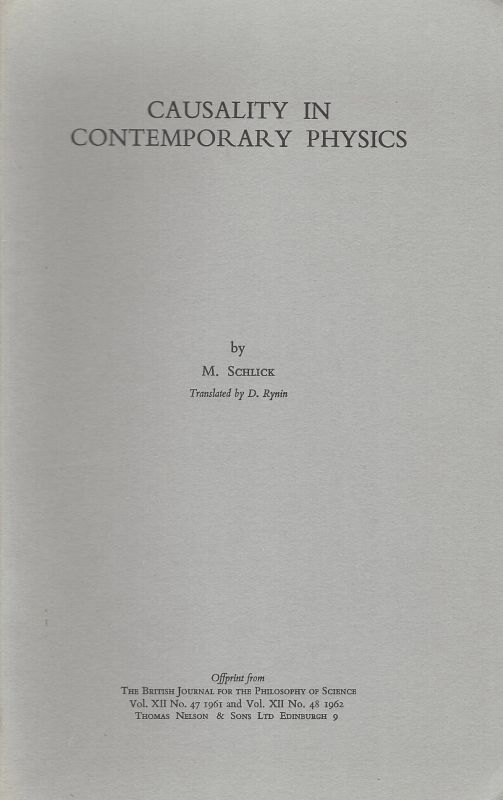Schlick, Causality in Contemporary Physics.
Causality in Contemporary Physics [Includes: “Indeterminateness of Nature and Freedom of the Will”]. Translated by D.Rynin (First published in “Die Naturwissenschaften,1931”).
Edinburgh, 1961. 8°. 21 pages. Softcover. Offprint form “The British Journal for The Philosophy of Science” – 1967.
Friedrich Albert Moritz Schlick (14 April 1882 – 22 June 1936) was a German philosopher, physicist, and the founding father of logical positivism and the Vienna Circle. Schlick was born in Berlin to a wealthy family. His father was Ernst Albert Schlick and his mother was Agnes Arndt. At the age of sixteen, he started to read Descartes’ Meditations and Schopenhauer’s Die beiden Grundprobleme der Ethik. Especially Also sprach Zarathurstra (Thus Spoke Zarathustra) by Friedrich Nietzsche would impress him.
He studied physics at the University of Heidelberg, the University of Lausanne, and, ultimately, the University of Berlin under Max Planck. Schlick explained this choice in his autobiography by saying that, despite his love for philosophy, he believed that only mathematical physics could help him obtain actual and exact knowledge. He felt deep distrust towards any metaphysical speculation.
In 1904, he completed his PhD thesis at the University of Berlin under the supervision of Planck. Schlick’s thesis was titled Über die Reflexion des Lichts in einer inhomogenen Schicht (On the Reflection of Light in a Non-Homogeneous Medium). After a year as Privatdozent at Göttingen, he turned to the study of Philosophy in Zurich. In 1907, he married Blanche Hardy. In 1908, he published Lebensweisheit (The Wisdom of Life), a slim volume about eudaemonism, the theory that happiness results from the pursuit of personal fulfillment as opposed to passing pleasures.
His habilitation thesis at the University of Rostock, Das Wesen der Wahrheit nach der modernen Logik (The Nature of Truth According to Modern Logic), was published in 1910. Several essays about aesthetics followed, whereupon Schlick turned his attention to problems of epistemology, the philosophy of science, and more general questions about science. In this last category, Schlick distinguished himself by publishing a paper in 1915 about Einstein’s special theory of relativity, a topic only ten years old. He also published Raum und Zeit in der gegenwärtigen Physik (Space and Time in Contemporary Physics), which extended his earlier results by applying Poincaré‘s geometric conventionalism to explain Einstein’s adoption of a non-Euclidean geometry in the general theory of relativity. (Wikipedia)
- Keywords: Catalogue Twelve – Philosophy · Pamphlets · Pamphlets Collection – Harvard · Philosophy Rare · Physics – Rare · Vienna Circle · Wiener Kreis
- Language: English
- Inventory Number: 17985AB
EUR 175,--
© 2024 Inanna Rare Books Ltd. | Powered by HESCOM-Software











